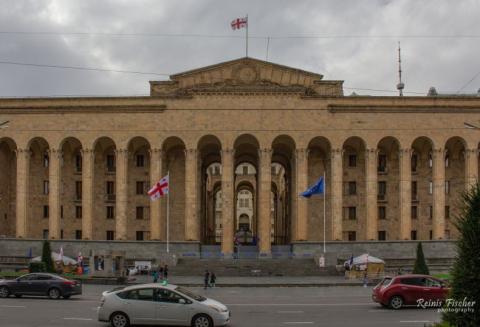The Parliament of Georgia Building is located in Tbilisi on Rustaveli Avenue, close to the foothills of Mount Mtatsminda.
The building complex was constructed as the House of Government of Georgian SSR on the site of the demolished 19th-century Alexander Nevsky Cathedral.
For those of you interested in Soviet Architecture, here you go another cool object of interest in Tbilisi. See: Brutal Tours - Explore Soviet Georgian Architecture in Tbilisi
The complex consists of two buildings; the "upper" building was designed by Viktor Kokorin and Giorgi Lezhava and built from 1933 to 1938. The "lower" building, along Rustaveli Avenue, was constructed by the same architects with input from Vladimer Nasaridze from 1946 to 1953. The two buildings are connected with a courtyard, with staircases and fountains. The design of both buildings heavily uses elements of traditional Georgian architecture.

Georgian Parliament Building in Tbilisi
The exterior facing the avenue is dominated by a monumental arcade, with massive eaves and "arch" pediment. The buildings are built of lightweight reinforced concrete, with exterior cladding of tufa rock, granite, and other materials.
The complex was severely damaged during the December 1991–January 1992 military coup, during which the beleaguered President Zviad Gamsakhurdia was entrenched in the underground bunker under the government premises. The building was subsequently restored, refurbished, and used as the seat of the Parliament of Georgia from 1997 to 2012, when the legislature moved to the newly constructed office in Kutaisi, Georgia's second most important city. See: Georgian Parliament Building (Kutaisi)
In 2014 holding of parliament committee meetings was allowed in the parliament premises of Tbilisi, while the regular sessions continued to be held in Kutaisi. The constitutional amendment passed in 2017 entered into force in December 2018, containing no reference to Kutaisi as the seat of the Parliament, meaning that the Parliament fully returned to the capital in January 2019.
